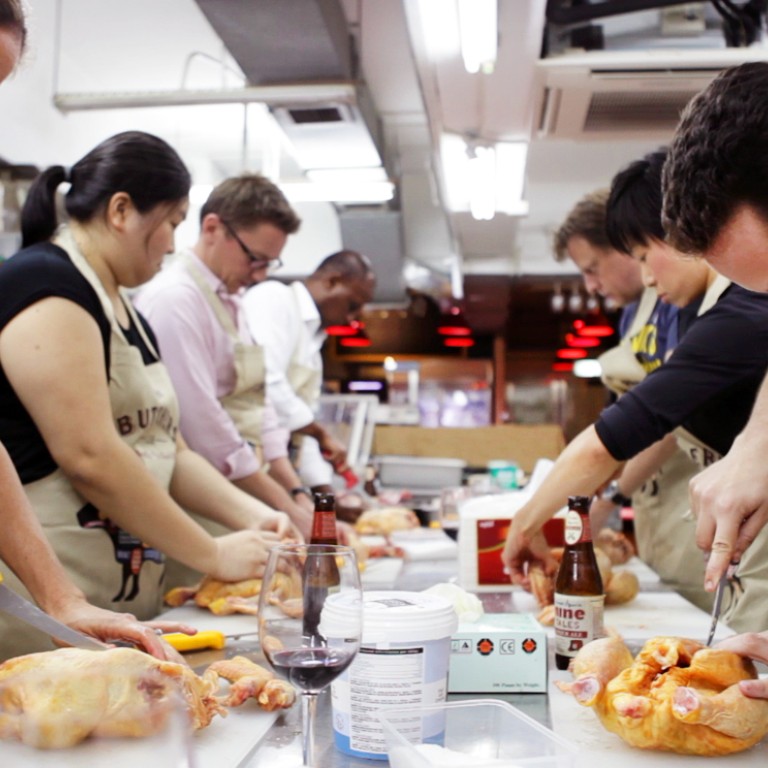
Butchery classes in Hong Kong show cleavage of Chinese and Western tastes
Butchery is a hot trend in the West, where classes for amateurs are commonplace. But Hong Kong has been slow to catch on. Visiting butchers from Italy have hosted dinners here, and The Butchers Club offers a basic course, complete with wine and a meal afterwards, with some success.
Even though knife skills are just as important in Chinese cuisine, the butchery trend has remained the purview of the expatriate community.
"It's all about following the seams," says Ned Nolan, a butcher at The Butchers Club restaurant group. "If you're cutting meat, you're probably doing it wrong."
He teaches students how to portion a chicken, prepare a lamb shank, and skin, and then wrap a slab of pork belly.
Although he is full of advice of what to do with every part of the beast, the focus is on prime cuts such as the loins and chops. The idea is to get to the best meat, and leave as much of it as possible, free of bones, and looking recognisable as a steak, tenderloin, or chop.
The work requires a good knowledge of the anatomy of the animal, as well as skill with the sharp boning knife used to work the meat away from the bone.
Watch our reporter in action with the butchers
Nolan has many years of experience. He started butchering when he was 15 at his local Italian butcher shop in Australia, where he was tasked with collecting meat scraps and making sausages. After decades wielding the knife, his cuts and strokes are effortless.
Nolan advises his class to let the natural make-up of the animal work to your advantage - "follow the seams" - and allow the weight of the meat under the knife to fall away due to gravity.
Some class members learn fast, but others leave chunks of good meat adhering to the bone, saw the flesh into a pink paste, or pierce holes in the meat with the tips of their knives.
Nolan's class is different to that taught by Chan Kam-sun, an instructor at the Chinese Cuisine Training Institute, part of the Hospitality Industry Training and Development Centre in Pok Fu Lam.
Most of Chan's students are working towards a career in cooking and Chan schools them in the basics of Chinese butchery and meat preparation: deboning chickens, preparing suckling pigs to be roasted, quickly chopping roast meats, and steaming chickens.
Nolan trains his students to use long narrow knives to carefully avoid bones, whereas Chan uses a Chinese cleaver to chop through them, leaving bone in each piece of meat.
While Nolan completely dismantles the animals, leaving a pile of perfect chops and recognisable cuts, Chan says "it is important to preserve the shape of the animal". He leaves the head on the deboned chicken, and even reassembles chunks of chicken meat in the shape of the plucked bird.
Chan has been cutting meat for more than 20 years. He started working in a roast meat shop at the age of 17 and it was there that he learned the importance of leaving meat on the bone. Many Chinese diners believe - like gourmands in the West - that meat on the the bone has more flavour.
There is also the issue of texture; Chinese diners like the texture and mouth feel of tearing flesh from bone, and think it important that meat resembles the animal from which it comes.
There are many kinds of cuts in Cantonese cuisine, and two distinct chopping techniques. Chan says that "we like to chop more than in the Western style", and says that he can perform every butchery task with just two kinds of cleaver.
His skills with the cleaver are especially impressive when he debones a whole chicken without cutting through the meat or piercing the skin, leaving what appears to be an intact chicken without bones.
When he prepares a suckling pig for roasting, he cuts some of the best meat away from the ribs, and discards it. This would be sacrilege to a Western butcher, but Chan explains that in Cantonese cuisine, "the focus for the suckling pig is on the skin, not the meat. The skin is the part you want to eat."
He removes as much superfluous bone and meat as possible so the piglet will cook faster, crisping up the skin so the crackling will shatter.
Nolan and Chan's styles of butchery have almost nothing in common, but they are both products of long-standing culinary traditions.

